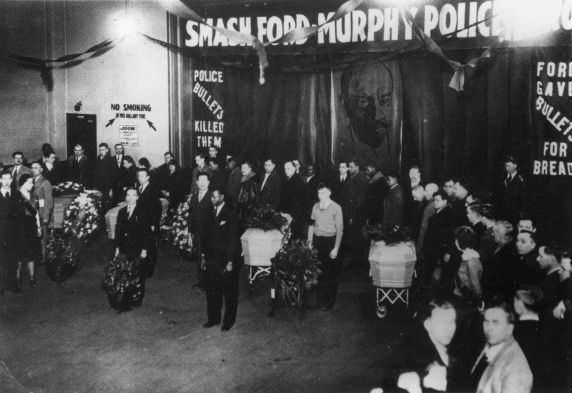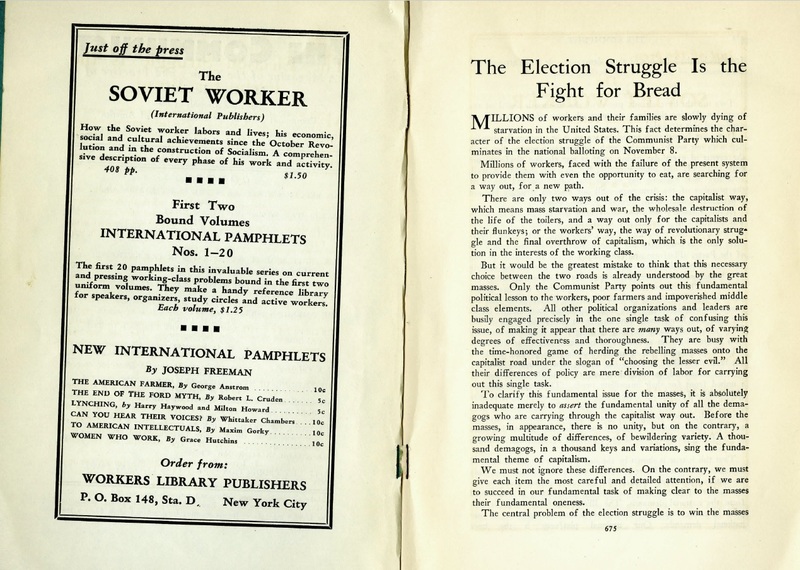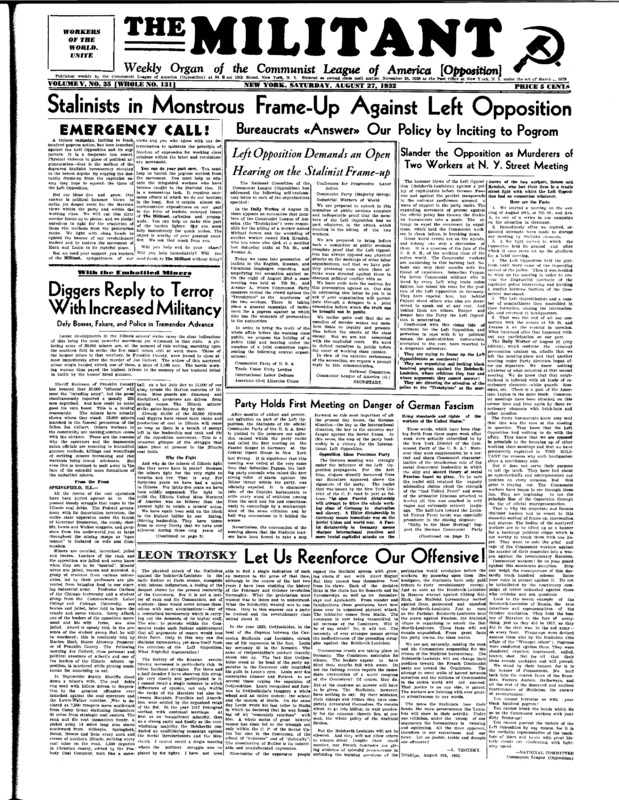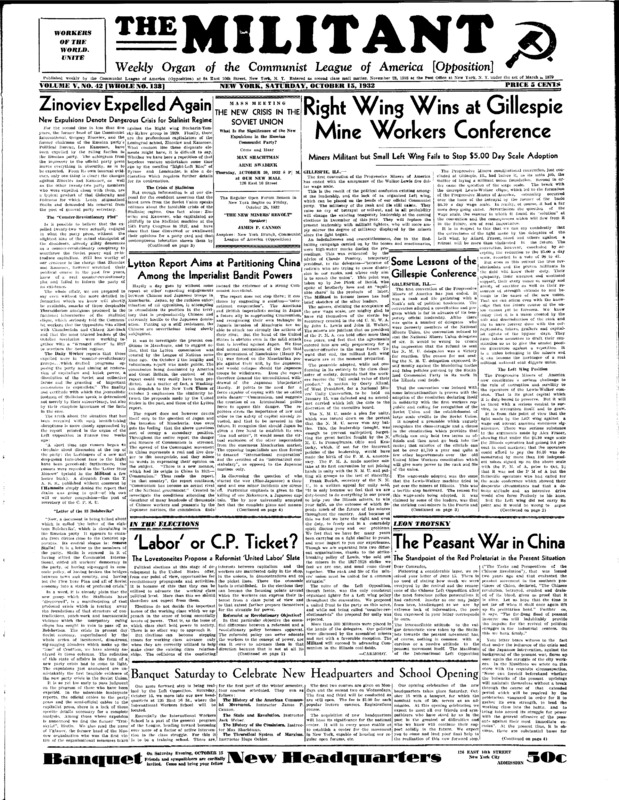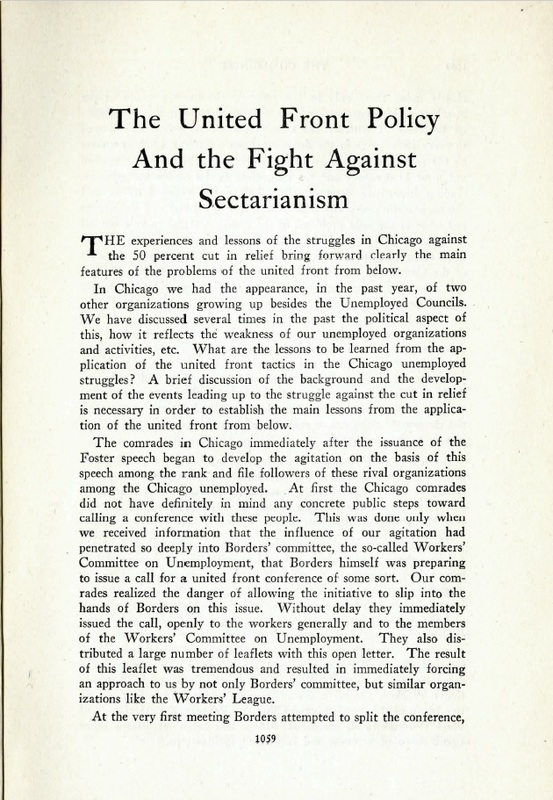Radicalism Teacher Plan
Getting Started
Leading into the 1932 Presidential Election that started the Franklin D. Roosevelt Administration, the United States had three political organizations all claiming to be Communist political organizations: The Communist Party of the United States of America (CPUSA, aka ‘the Stalinists’), the Communist League of America (CLA, aka ‘The Militants’), and the Communist Party Opposition (CPO, aka the ‘Lovestoneites’). While all three organizations claimed to uphold the ideals and virtues of Marxist-inspired communist ideology, they functioned independently and had different approaches to U.S. politics. This lesson unit will examine a few documents from the CPUSA, CLA, and CPO using document-based inquiry to identify the differences between these organizations that shared the same fundamental political ideology.
Give a brief reminder to students that primary sources should be treated as a piece of evidence in the overall process of investigating the subtle, yet significant, differences between these political organizations. Give an introduction to the concept of asking the 5ws: when reading a document, ask "who" "what" "where" "when" and "why" just like a journalist or a detective investigating clues relating to an important event, person, or time period. Then divide students into small groups and assign each group one of the documents below. Students should spend 5-10 minutes in groups of 3 to 5 to read through the documents, discuss the 5ws, and take notes on what they think the document is both trying to represent and express. Afterward, regroup the students to discuss their findings, comparing and contrasting. As you guide students through the group discussion, remind them to base their arguments in evidence they find in the documents, not in preexisting judgments.
Expect to spend roughly 15-20 minutes on this lesson's context assignment and another 30-40 minutes for the small and large group exercise. The lesson can be broken into two sessions with a homework assignment in between class meetings if so desired.
This lesson plan addresses area 7.2 - P1.2, P1.5 P2.1 of the Michigan Social Studies Standards.
Context Assignment
This project asks students to investigate some complex philosophical ideas present during the Great Depression’s monumental presidential election of 1932.
Step 1
Start off the entire process by reading this quote to the students: “This nation, with its institutions, belongs to the people who inhabit it. Whenever they shall grow weary of the existing government, they can exercise their constitutional right of amending it, or exercise their revolutionary right to dismember and overthrow it.” – Abraham Lincoln
It is a good idea to start off the discussion or individual homework assignments where students answer: What does being a political radical mean?
Step 2
After students assess and discuss the meaning of “radical” in American politics, give some basic information on the history of radical politics in the United States:
- Some would argue that the United States was born out of radicalism.
- Landed politicians wanted to protect what they viewed as their property and ensure that British officials couldn’t take it from them.
- Everyday colonial Americans desired to see their social conditions improve over time and an end to taxation without representation.
- In 1800, many viewed Thomas Jefferson’s election platform as too divisive and believed it would undo the nation by splitting it.
- Jefferson, by then an aging founding father, ran against John Adams with a focus on either the centralization or decentralization of federal power.
- Jefferson came out the winner after a long and heated electoral cycle, leaving defeated Federalists worried that the young nation would unravel.
- European leaders also worried that such a new Republic would not be able to deal with divisive issues like federal taxation and the authority of the federal government over the states.
- In the end, the peaceful transfer of power from Adams to Jefferson signaled to the world that radical politics in the United States did not necessarily mean an end to the political process.
- Finally, radicalism can be seen as the polar ends of the issues at stake within the American Civil War.
- Before Lincoln’s election, abolitionism was a central issue, though it was not that radical for its time. The response by Southern Democrats, however, was radical and ideologically motivated.
- The South rejected Lincoln’s election because his political party advocated an expansion of the United States without an expansion of slavery. Their solution was to secede from the nation before Congress could act to control their socioeconomic way of life by ending slavery.
- The North subsequently took a radical approach to both the Civil War and the issue of abolitionism after it was made it clear that the South desired war.
- Taking advantage of the lack of Southern Democrat resistance, the Republican-dominated Congress passed the 13th and 14th Amendments, abolishing slavery and giving citizenship to former slaves.
In these examples we see how "radical" politics both have contributed to the development of the nation as well as forced it into conflicts. More importantly, the issues that we deem as ‘radical’ seem less radical not only as time goes by, but also as the ideas within the radical groups become more accepted by society.
For example, opposition to taxation without representation, today, is not a radical concept. But to the revolutionaries of 1776 and the British authorities they resisted, it was radical enough to spur a war. Likewise, many believed that the politics of Jefferson leading into the 19th century were too radical to maintain the Republic, but these fears proved unfounded.
Students should be reminded to consider these examples both when examining primary sources and when looking at political movements today.
Step 3
For more advanced courses and Advanced Placement, consider a quick overview of socialism/communism as a radical sect of politics stemming out of Central Europe in the 1850s and 1860s. Point out that socialists/communists desire an end to both the government and the economy in their current forms, but they do not desire them to be fully destroyed (that would be anarchism). See Below for Suggested Reading for Step 3.
- Karl Marx & Frederick Engels. The Communist Manifesto
- Marx’s most popular work on Communism and a work written specifically for the lower classes of Europe in terms of its prose, language, and emphatic nature.
- Marx’s argument is that all of history is an evolutionary struggle between those with power and those who lack power.
- Frederick Engels. Socialism: Utopian and Scientific
- Marx’s close associate Engels wrote this text in 1880 to describe differences between an idealistic and a practical means for both understanding history as well as how to bring about social change.
- Anarchists and Democratic Socialists are depicted as “utopians” who fail to grasp the militant nature of social progress and the necessity for the overthrow of the state.
- Paul D’Amato. The Meaning of Marxism, Chapter 1
- Scholar of Marxism D’Amato unpacks the philosophical significance of Marx’s ideas in the grand scheme of Western civilization and philosophy in general.
- D’Amato brings the narrative to the present, and discusses how many of Marx’s ideas remain relevant in contemporary post-Cold War society.
Digging into Documents
Offer some leading context moving into the first document. This document comes in March, 1932, a Presidential Election year and deep within the Great Depression. While the two big political parties battled it out in Washington to see who would take on the burden of resolving the Depression, most everyday American citizens continued to push for an expansion of unemployment rights and higher wages for those employed. Since the Depression began in 1929, by 1932 we reached a point where a growing number of Americans began to lose faith in the mainstream political system and turned to alternatives offered by radical political groups such as socialists and communists.
What is the document? What stands out?
- A photograph taken at the Detroit Communist Party headquarters in the aftermath of the Ford Hunger March
- Of significant note is the phrase “Ford gave bullets for bread,” suggesting that the Ford Motor Company shares a burden of the guilt with the police.
Who is in the document? Who is it for?
- Pictured are the coffins of Joe York, George Bussell, Coleman Leny, and Joe Blasio; four men killed during the Ford Hunger March after William Foster gave a speech about his presidential campaign. In the center is Christopher Alston, future organizer for the UAW at Ford Motor Company
- The banners in the back mention Ford and Murphy, referring to Ford Motor Company founder Henry Ford and Detroit mayor Frank Murphy.
Where is the evidence in the document taking place?
- This public viewing of those killed during the march took place at Detroit’s Communist Party Headquarters just prior to the internment of the bodies at Woodmere Cemetery.
When does the document take place?
- The photograph was taken on March 12th, 1932, 5 days after the Ford Hunger March from downtown Detroit to the Ford River Rouge Complex in Dearborn, using Michigan Avenue.
Why is this photograph significant? Why was it created and ultimately kept?
- Remember, it is important to question why the photograph displays what it does. Why did the Communist Party frame the death of four Detroit workers in the context of a fight for bread? Why did the Communist Party blame Ford Motor Company for the deaths, in addition to the police?
Wonder+
This photograph is key for setting the stage to discuss differences between radical in the 1932 election. It denotes, primarily, that the communists are involved in workers’ organizing efforts and that they viewed their presence in these efforts as necessary to creating their political identity. It also importantly identifies “bread,” a basic food for subsistence, as an ideal to fight for; making it clear that the program of the Communist Party focuses on relief for the unemployed masses. The photograph leaves much open for interpretation, particularly how significant the death of four communists was to the broader masses of Detroit.
Document 2: “Election Struggle is the Fight for Bread.”
The Communist, Vol. 11, No. 8, August 1932
What is this document telling us as researchers? What does the document not tell us about the Communist political programme? What does the previous photograph share with this document in terms of language?
Who is the document speaking to? Are the Communists running an election for just working people, or are they trying to appeal to everyone?
Where does the Communist Party say this electoral fight should be fought? In the streets? In the workplace? At the ballot box?
Students should be reminded to consider when the document is released, just at the start of fall and the ramping up of the electoral process. What is common protocol for political parties during the early portion of a Presidential campaign? It is also after the Ford Hunger March funeral depicted in the first document (photograph).
Why are the communists appealing for electoral votes on the basis of a “fight for bread”? How are the communists framing the context of the election? Why does the author insist that there are only two possible routes for the future? What does this tell us about how communists felt about their movement moving into the Great Depression?
+Wonder
- This kind of primary source gives us overt and subjective clues about the mindset of communist party leaders leading into the 1932 presidential election. Because the document is so self-expressive of a particular view, students should be encouraged to ask why a radical political organization would appeal to a sort of black/white, bifurcated narrative about the possibilities for future change and how this separates out “radicals” from “moderates”
- Building off this, students should also question why the Communist Party is even advocating participation in an election as opposed to making calls for revolution
- Students should be encouraged to contrast the issues brought forth by the CPUSA to the electoral platform of Franklin Roosevelt through other primary and secondary sources, such as the Democratic Party’s electoral campaign throughout the same year.
Potential Assignment: Ask students to write an essay in which they argue whether or not this is a practical call for votes, or an idealistic call for revolution. Be sure students use key examples to explain their position.
Document 3: “The Communists and Election Activity: A Criticism of the Stalinist Methods in the Campaign.”
The Militant, Vol. 5, No. 35. August 27, 1932
What is different about the source? What does this other Communist organization, the CLA, have to say about the Communist Party’s election platform? In their view, what should be the ideals to fight for in the 1932 election?
Who is the author referring to as the “parties of reaction, reform, and revolution?”
- Democrats = Reaction; Socialists = Reform; Communists = Revolution
This article doesn’t mention much in the where field of research, but it does offer us international movements to consider elsewhere:
- Rising Fascism in Europe
- National Security of the Soviet Union (USSR)
- The questionable legitimacy of the anti-communist government in China
It is important to consider when this document was published in comparison to document 2, which was published just earlier in the month.
- It should be assumed or concluded that this article is a response by the CLA to the Communist Party’s previous electoral program explained by document 2.
- Because of this, students should consider this an important factor of the document; one cannot fully understand it unless they contrast it to the previous primary source.
Why does the CLA suggest that the Communist Party failed at their task of both defending the USSR and the Chinese communist movement, as well as rejecting the legitimacy of fascism in Germany? Why does the author suggest that only by linking in global political shifts, such as the rise of the Nazi Party in Germany and the fascists of Mussolini, can Americans have “political consciousness” to make informed voting choices?
+Wonder
The document brings forth a few ideals that still to this day classify as “radical” for political engagement, particularly the insistence upon linking “immediate demands” with the “ultimate demand” of revolution. Students should look back at the previous document and question what they feel the Militant means by revolution. Similar to the previous document, students should ask “can an electoral campaign be revolutionary? If so, how?”
Examples elections sometimes classified as “revolutionary” in U.S. History:
- The “revolution of 1800” and the election of Thomas Jefferson
- The election of Abraham Lincoln in 1860
- The 2008 election of the nation’s first African-American President
Document 4: A.S. “Labor or CP Ticket? The Lovestoneites Propose a Reformist ‘United Labor’ Slate.”
The Militant, Vol. 5, No. 42. October 15, 1932. Pp. 1&2
What does this document have to say about the election campaign as the timeline gets closer to November? What new ideas are brought forward? What does the document tell us about the differences between communist groups?
Who are the Lovestoneites and what do they stand for in the words of the CLA’s Militant?
When? What dates stick out that give clues for further research into the matter?
Where? Places discussed by the article, such as New York City: What does this suggest about the presence of Lovestoneites in major urban areas versus rural areas?
Why does the CLA describe the CPO as “opportunist”? Why does the CLA state that the Lovestoneites should simply confine themselves into the broader camp of communists? Why might the Lovestoneites refuse to cooperate with the CPUSA and CLA?
Wonder+
At this point students should be processing the fact that three different organizations with what could be described as superficial and identity-related differences nevertheless had staunch reservations about how to properly engage in electoral politics. Students should ask themselves: Do radical groups like the CPO create alternative methods because they genuinely believe them to be superior, or do they do it merely to contrast themselves against their ‘other’? Was the CPO’s call here a genuine call for votes or was it a further attempt to divide the more dominant CPUSA? What issues are NOT discussed in this article which could be investigated further to understand these differences?
- Some students might properly point out that you cannot fully understand a domestic communist movement in the 1930s without bringing in some discussion of the international communist movement led in part by Soviet Russia.
- Behind the veil of their ideological rhetoric, the differences of these three communist groups boils down to their support or lack of support for ideas pushed by the Soviet Union.
- This is, in part, why the CLA describes the CPUSA as “Stalinist”—the accusation being that they are ideological minions of Joseph Stalin.
- Likewise, the CLA describes the CPO as “opportunist” because of its inclination to support ideas promoted by the Socialist Party.
If one were to draw a spectrum of these groups, it might look like this:
Far Left-------CLA-----CPUSA-----CPO-----Socialist Party------Democratic Party----Center
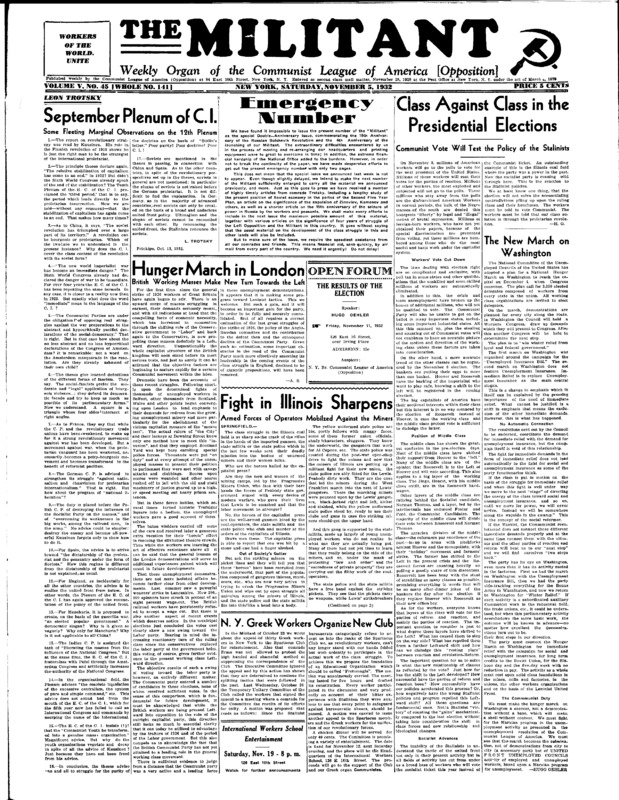
Class Against Class in the Presidential Elections: Communist Vote Will Test the Policy of the Stalinists.
"Class Against Class in the Presidential Elections: Communist Vote Will Test the Policy of the Stalinists." November 5, 1932
Document 5: H.O. “Class Against Class in the Presidential Elections: Communist Vote Will Test the Policy of the Stalinists.”
The Militant, Vol. 5, No. 45. November 5, 1932. Pp. 1
When is perhaps the most important question for this document, since it was published just 7 days before the national election. It is the closest document to the election that we are examining highlighting the ideals and motivations of American radicals in the Great Depression.
What does the communist periodical bring up about the election that it left for the last minute? What major tenets remain from the earlier documents about the Communist Party platform?
Where across the United States does the author feel the election will have the most impact or significance? Which areas will in turn most significantly impact the election?
Who is the Middle Class in this article? What amount of agency does the author give them in terms of being active elements in the history?
+Wonder
It is important for students to try and connect what they already know both from previous documents and from their general knowledge with the individuals and policies mentioned in this document. The document brings up Hearst, referring to William Randolph Hearst, Roosevelt, Socialist Party Candidate Norman Thomas, and the Communist candidates William Foster and James Ford. This is also the third time students will have seen the communists use the phrases “reform,” “reaction,” and “revolution.” They should perhaps ask how have these terms been used throughout the documents.
Document 6: “The CP In the Elections: Reasons for Small Rise in Communist Vote”
The Militant, Vol. 5, No. 47. November, 1932.
What is the initial response to the electoral outcome by the CLA? Did the election meet or fall short of expectations? Did the CLA hope to win, or what did they expect? What does this document NOT tell us about the views of communists about the election?
Who is given central agency by this article? Who does the CLA attribute success or failure to?
Where does the author expect the movement to go from here? Is location given agency at all?
The CLA released the article 15 days after the election, so this makes it one of the first post-election communist articles; giving us a clue as to when communists began to assess their mistakes.
Why, or How does this article delineate clear differences between the CLA and the CPUSA? Why does the CLA insist that the electoral outcome is a rather simple to understand as opposed to profound or complex?
Document 7: “United Front Policy and the Fight Against Sectarianism”
The Communist, Vol. 11, No. 12. December, 1932.
This final document brings the failures of the 1932 electoral program and the overarching political fight against unemployment together to create a new political vision for American Communism by the start of 1933. Much would change about the communist movement in the United States from 1933 to 1934 as both domestic events, such as the popularity of Roosevelt’s First Hundred Days, and international events, such as the appointment of Adolf Hitler to the chancellery of Germany, transformed the fundamental nature of politics in the Western world. This final document forces the students to look at the ending resolutions of the electoral cycle for the Communist Party and where they viewed their role in upcoming events.
What is the document telling us about the stance of Communists after the election? What does this tell us about the response of radicals to their own shortcomings?
Who does the document involve? What other groups/organizations does it mention?
Where does the document take place? What significant locations standout?
When does it take place? The document is published almost a month after the Chicago united labor conference, which took place in early November, 1932, not long after the results of the Presidential election were released. It was also published a month before Roosevelt took office, and about a month and a half before Adolf Hitler rose to power.
Why is this document significant? Key kinds of “whys” are significant here: Why did the CPUSA feel that the situation in Chicago was more important over other areas, such as New York City, with regard to unemployment? Why did the communists believe that the Socialists and the Chicago Committee on Unemployment represented a “right danger” for the fight against unemployment? Students should try to evaluate how and why these particular issues became so divisive for what could have been a rather unified political conference.
+Wonder. A primary source that comes from a political creator like the Communist Party of the United States of America requires the researcher to be diligent in breaking down both the overtly subjective elements presented by the author and the more objective elements presented by the contextual situation. Students should be encouraged to question why the Communist Party’s desire to focus on unemployment as a major divisive issue between other like-minded political groups, as opposed to issues such as the stock market crash, or the political tenets of the mainstream Republican and Democratic parties. Why, for example, did communists spill much ink over a divisive issue instead of focusing on what similarities they had? Why are these particular and specific issues so significant to communists?
